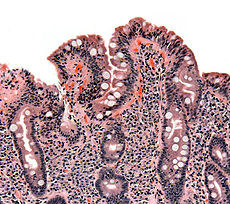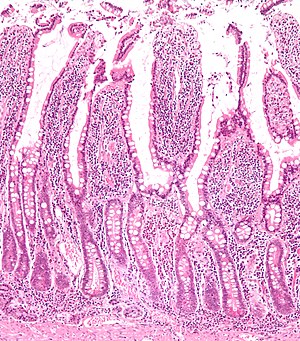Villi are tiny sack-like structures that line the inside of the small intestine. They are responsible for absorbing nutrients and producing certain digestive enzymes. Damaged villi are considered the primary symptom of celiac disease.
The primary function of the villi is to increase the surface area of the intestine to increase absorption of nutrients from digested food.

Villi (singular: villus) are range in length between 0.5 and 1.6 mm. Each villus is covered in microvilli, further increasing surface area and therefore food absorption. Over all, the villi multiple the surface area of the small intestine wall by 30 to 60 times. The villi absorb nutrients and then transfer them to blood which flows through capillaries in the villi.
Villi and Lactase
Lactase, the enzyme responsible for digesting lactose, which is found in milk, is produced in the tips of the villi. Without lactase, milk cannot be properly digested, resulting in flatulence, abdominal discomfort and diarrhea.
Damaged Villi and Celiac Disease
Celiac disease causes severe damage to the villi (as well as other organs in the body). Instead of the finger-like projections into the intestinal flow of nutrients, they become blunted, poorly absorbing nutrients, and absorbing partially digested foods. This can cause many problems, see celiac disease symptoms for details.


References
- Lactose Intolerance: Considerations for the Clinician
- Wikipedia
- Images from Wikipedia